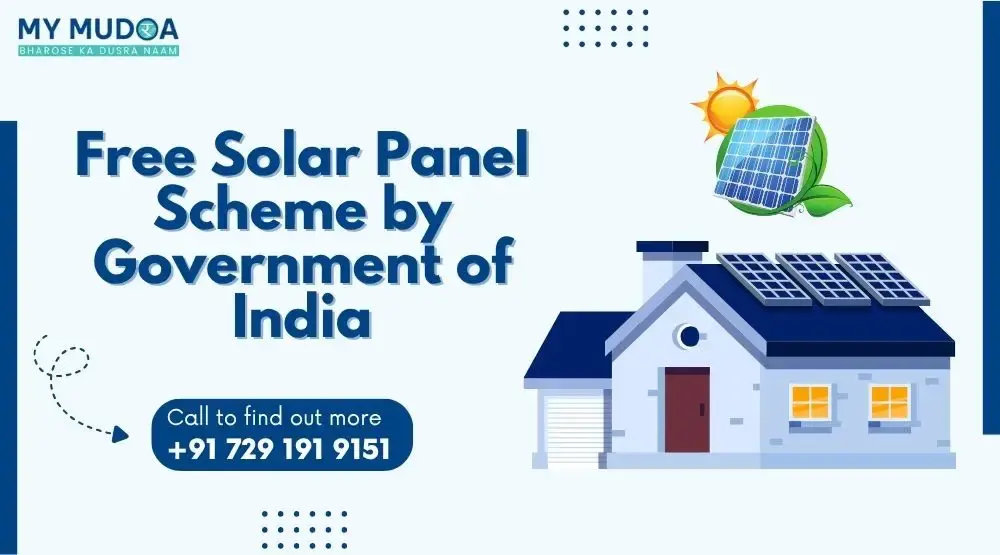
"Explore the free solar panel scheme by Government of India. Learn how to get solar panels for home with this government solar scheme easily."

Published: 7 July 2025
Updated: 21 July 2025
Zero electricity bills. A cooler planet. And solar panels on your rooftop. Isn’t it something that we all would love to look forward to? All thanks to the free solar panel scheme by the Government of India. Sounds too good to be true? It’s actually happening, and millions of Indian families are already lining up to benefit from this solar panel scheme.
Let’s break down how the government solar scheme works, who can apply, what you get, and how you can make the most of solar panels for home government schemes. Plus, we’ll answer all your burning questions and show you how to get started — step by step.
The flagship initiative, officially called PM Surya Ghar: Muft Bijli Yojana, was launched in 2024 to make solar energy affordable for every Indian household. The government solar panel scheme aims to provide free electricity to one crore homes by offering a hefty subsidy for installing rooftop solar panels. The result? Lower bills, cleaner energy, and a big step toward India’s green future.
Not everyone qualifies for the scheme automatically. Here’s what you need to fulfil to be eligible:
Here’s a quick look at the subsidy slabs under the solar panel scheme:
|
Average Monthly Electricity Use |
Suitable Rooftop Solar Plant |
Subsidy Support |
|
0-150 units |
1-2 kW |
₹30,000 – ₹60,000 |
|
150-300 units |
2-3 kW |
₹60,000 – ₹78,000 |
|
Above 300 units |
Above 3 kW |
₹78,000 (capped) |
Note: The subsidy is directly credited to your bank account after installation and inspection by your local electricity board (DISCOM).
Applying for the solar panels for home government scheme is simple and can be done online. Here’s a step-by-step guide for you:
Step 1: Visit the official PM Surya Ghar portal
Step 2: Register by selecting your state, your electricity distribution company, and entering your consumer number, mobile, and email.
Step 3: Log in and fill out the online application form for the rooftop solar system.
Step 4: Wait for feasibility approval from your DISCOM.
Step 5: Choose a registered vendor from the portal and install your solar panels.
Step 6: After installation, apply for a net meter and request inspection.
Step 7: Once your system is inspected and commissioned, upload your bank details and cancelled cheque.
Step 8: The subsidy will be transferred to your account within 30 days.
A typical residential solar setup can cost anywhere from ₹50,000 to ₹6 lakhs, depending on the size and quality. You might be concerned whether the Government Solar Scheme would be enough to finance your solar energy dream. The good news is many banks and NBFCs offer solar rooftop loan and solar panel loans at competitive rates, so you don’t need to worry about upfront costs. These loans can help you cover the amount remaining after the government subsidy, making solar affordable for nearly every household.
Solar is taking India by the storm, with many Indian households making the switch from traditional electricity. At My Mudra, we help you compare solar panel loans, find the best solar rooftop loan for your home, and guide you through every step of the government solar scheme application. You focus on enjoying free, clean energy — we’ll handle the paperwork.
Also Read:
- How to Apply for Solar Subsidy in India
- Top Banks & NBFCs Offering Solar Project Loans in India
Ans: It’s a government solar panel scheme that offers up to 40% subsidy for rooftop solar installations, aiming to provide free electricity to one crore households.
Ans: Indian citizens who own their house, have a valid electricity connection, and haven’t availed solar subsidy before.
Ans: Register online at the official portal, fill out the application, get approval, install the system, and submit your bank details for the subsidy.
Ans: Up to ₹78,000, depending on your system size and average monthly usage.
Ans: Yes, you can apply for a loan for solar rooftop for home from various banks and NBFCs to cover the balance after subsidy.
Ans: Yes, only empanelled vendors listed on the portal are eligible for subsidy.
Ans: Usually within 30 days after installation and inspection.
Ans: No, only property owners are eligible.
💬 Comments
Leave a comment or ask a question!
Please Enter Your Name
Please Enter Your Email
Please Enter Your Phone
Please Write Your Comment